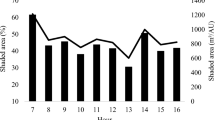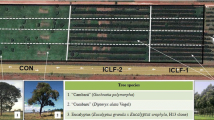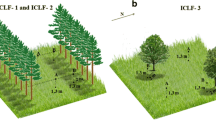Abstract
The objective of this study was to assess the use of infrared thermography as a microclimate-evaluating tool and an estimate of the thermal comfort provided by four types of tree to cattle under grazing conditions in the central region of Brazil. The experiment was conducted at the Embrapa Beef Cattle Company, in Campo Grande, MS, Brazil, from June to August 2015. Evaluations were carried out over four consecutive days, at 1-hour intervals, from 8:00 a.m. to 4:00 p.m. (local time; GMT − 4:00). Infrared thermography images of tree crowns and soil surface underneath them from the shadow projection of four tree species native to the Brazilian cerrado (savannah-like) biome were obtained. The microclimate was assessed by estimation of thermal indices: temperature and humidity index, black globe, and radiation thermal load. The previous was calculated based on records of air temperature, dew point temperature, black globe temperature, air relative humidity, wind speed, and solar radiation. The geometrical settings of the trees were assessed for each tree component. Five thematic groups were formed based on multiple factor analysis that summarizes three synthetic analytical dimensions to explain the total variance among the studied elements and the existing correlations between groups. Positive linear correlations were found between thermography and the temperature measurements, thermal comfort indices, and radiation, suggesting that infrared thermography can be used as a tool for estimating and monitoring the microclimate and thermal comfort, presenting a potential use of measurement in agroforestry systems.






Similar content being viewed by others
References
Abreu LV, Labaki LC (2010) Conforto térmico propiciado por algumas espécies: avaliação do raio de influência através de diferentes índices de conforto. Ambient Constr (Online) 10:103–117
Albatici R, Tonelli AM (2010) Infrared thermovision technique for the assessment of thermal transmittance value of opaque building elements on site. Energ Buildings 42:2177–2183
Alves FV (2012) O componente animal em sistemas de produção em integração. In: Bungenstab, DJ , (ed). Sistemas de integração lavoura-pecuária-floresta: a produção sustentável, Embrapa Gado de Corte, Campo Grande, MS, Brasil 53-59
Andersen HML, Jørgensen E, Dybkjær L, Jørgensen B (2008) The ear skin temperature as an indicator of the thermal comfort of pigs. Appl Anim Behav Sci 113:43–56
Balaras CA, Argiriou AA (2002) Infrared thermography for building diagnostics. Energ Buildings 34(2):171–183
Barreira E, De Freitas VP (2007) Evaluation of building materials using infrared thermography. Constr Build Mater 21:218–224
Buffington DE, Collazo Arocho A, Canton GH, Pitt D (1981) Black globe humidity index (BGHI) as a comfort equation for dairy cows. Trans Am Soc Agric Eng 24(3):711–714
Catena A, Catena G (2008) Overview of thermal imaging for tree assessment. Arboric J 30:259–270
Cattelam J, Vale MM (2013) Estresse térmico em bovinos. Rev Port Ciênc Vet 108:96–102
Clark MR, Mccann DM, Forde MC (2003) Application of infrared thermography to the non-destructive testing of concrete and masonry bridges. NDT & E Int 36:265–275
Collier RJ, Beede DK, Thatcher WW, Israel LA, Wilcox CJ (1982) Influence of environment and its modification on dairy animal health and production. J Dairy Sci 65:2213–2227
Costa E, Silva E, Katayama K, Macedo G, Rueda P, Abreu U, Zúccari C (2010) Efeito do manejo e de variáveis bioclimáticas sobre a taxa de gestação em vacas receptoras de embriões. Ciênc Anim Bras 11(2):280–291
Da Costa PA, Saraiva EP, Saraiva CAS, Fonseca VDFC, Almeida MEV, Dos Santos SGGG, Neto PJR (2015) Características anatomofisiológicas de adaptação de bovinos leiteiros ao ambiente tropical. Agrotec 36(1):280–293
De Moura DJ, Maia APDA, Vercellino RDA, Medeiros BB, Sarubbi J, Griska PR (2011) Uso da termografia infravermelha na análise da termorregulação de cavalo em treinamento. Eng Agric 31:23–32
Escofier B, Pagès J (2008) Analyses factorielles simples et multiples: objectifs, méthodes et interprétation. Dunod
Esmay ML (1979) Principles of animal environment.Avi Publishing, Porto Oeste
Fokaides PA, Jurelionis A, Gagyte L, Kalogirou SA (2016) Mock target IR thermography for indoor air temperature measurement. Appl Energy 164:676–685
Incropera FP, Dewitt DP (2003) Fundamentos de troca de calor e de massa. Editora, Rio de Janeiro, Brasil
Karvatte Junior N, Klosowski ES, de Almeida RG, Mesquita EE, de Oliveira CC, Alves FV (2016) Shading effect on microclimate and thermal comfort indexes in integrated crop-livestock-forest systems in the Brazilian Midwest. Int J Biometeorol 60:1–9
Lebart L, Piron M, Morineau A (2000) Statistique exploratoire multidimensionnelle. Dunod, Paris
Ocaña SM, Guerrero IC, Requena IG (2004) Thermographic survey of two rural buildings in Spain. Energ Buildings 36:515–523
de Oliveira CC, Alves FV, de Almeida RG, Gamarra ÉL, Villela SDJ, de Almedia Martins PGM (2017) Thermal comfort indices assessed in integrated production systems in the Brazilian savannah. Agrofor Syst 92(6):1659–1672
Paim TP, Borges BO, Lima PMT, Dallago BSL, Louvandini H, McManus C (2012) Relation between thermographic temperatures of lambs and thermal comfort indeces. Int J Appl Anim Sci 1(4):108–115
Pereira AR, Angelocci LR, Sentelhas PC (2002) Agrometeorologia “Fundamentos e Aplicações Práticas”. LivrariaEditora Agropecuária, Guaiba-RS
Roberto JVB, de Souza BB (2014) Use of infrared thermography in veterinary medicine and animal production. J Anim Behav Biometeorol 2:73–84
Roberto JVB, Souza BB, Furtado DA, Delfino LJB, Marques BAA (2014) Gradientes térmicos e respostas fisiológicas de caprinos no semiárido brasileiro utilizando a termografia infravermelha. J Anim Behav Biometeorol 2:11–19
Sevegnani KB, Fernandes DPB, Silva SH (2016) Evaluation of thermorregulatory capacity of dairy buffaloes using infrared thermography. Eng Agric 36:1–12
Shao B, Xin H (2008) A real-time computer vision assessment and control of thermal comfort for group-housed pigs. Comput Electron Agric 62:15–21
Silva RG (2006) Predição da configuração de sombras de árvores em pastagens para bovinos. Eng Agric 26:36–281
Souza CF, Tinôco IFF, Baêta FC, Ferreira WPM, Silva RS (2002) Avaliação de materiais alternativos para confecção do termômetro de globo. Ciênc Agrotec 26:157–164
Stewart M, Webster JR, Schaefer AL, Cook NJ, Scott SL (2005) Infra-red thermography as a non-invasive tool to study animal welfare. Anim Welf 14:319–325
Thom EC (1959) The discomfort index. Weatherwise 12(1):57–60
Thompson J, Marvin M (2005) Experimental research using thermography to locate heat signatures from caves. National Cave and Karst Management Symposium: 102–114
Trumbo BA, Wise LM, Hudy M (2012) Influence of protective shielding devices on recorded air temperature accuracy for a rugged outdoor thermal sensor used in climate change modeling. Natl Environ Sci 3(1):42–50
Acknowledgements
We thank Universidade Federal do Recôncavo da Bahia (UFRB), Embrapa Beef Cattle, Conselho Nacional de Desenvolvimento Científico e Tecnológico (CNPq), Fundação de Amparo à Pesquisa do Estado da Bahia (Fapesb), Fundação de Apoio ao Desenvolvimento do Ensino, Ciência e Tecnologia do Estado de Mato Grosso do Sul (Fundect). Without their support, this research would not have been possible.
Author information
Authors and Affiliations
Corresponding author
Additional information
Publisher’s note
Springer Nature remains neutral with regard to jurisdictional claims in published maps and institutional affiliations.
Rights and permissions
About this article
Cite this article
Barreto, C.D., Alves, F.V., de Oliveira Ramos, C.E.C. et al. Infrared thermography for evaluation of the environmental thermal comfort for livestock. Int J Biometeorol 64, 881–888 (2020). https://doi.org/10.1007/s00484-020-01878-0
Received:
Revised:
Accepted:
Published:
Issue Date:
DOI: https://doi.org/10.1007/s00484-020-01878-0




